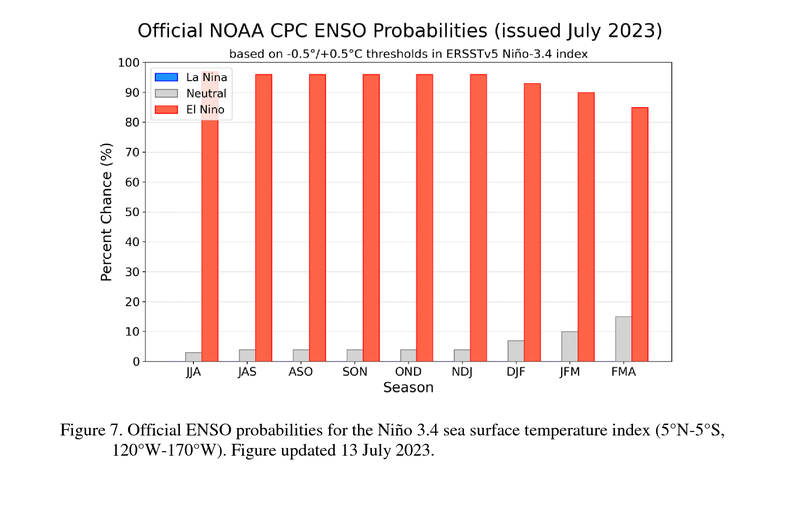El Niño Southern Oscillation and Indian Ocean Dipole Watch for the Eastern Africa - short rains season (October-December 2023)

The October-November-December (OND) rainfall season in Eastern Africa is significantly influenced by two phenomena: the El Niño Southern Oscillation (ENSO) and the Indian Ocean Dipole (IOD). ENSO is characterised by abnormal warming or cooling of the Sea Surface Temperatures (SSTs) over the central and eastern equatorial Pacific Ocean. During El Niño (warm phase of ENSO), the SSTs over the central and eastern Pacific Ocean become warmer than usual, and SSTs over the western part of the ocean become cooler than usual. On the other hand, the IOD is defined by Sea Surface Temperatures gradient between the western and eastern parts of the Indian Ocean. During the positive phase of IOD, warmer than usual SSTs are observed over the western parts of the Indian Ocean, while cooler than usual SSTs are observed in the eastern parts of the Indian Ocean.
El Niño is frequently associated with enhanced rainfall in the eastern part of Eastern Africa during the OND season. Conversely, during the La Niña phase of ENSO when the SSTs are reversed, suppressed rainfall is often observed in the equatorial parts of the region, as experienced in OND 2020, 2021, and 2022. While an El Niño event typically corresponds to above-average rainfall in the Eastern Africa region, it is important to note that local drivers also exert a significant influence, resulting in varying effects of El Niño each year. For instance, despite 2018 being an El Niño year, most parts of the region received below-average rainfall during OND. Similarly, a positive Indian Ocean Dipole (IOD) event contributes to enhanced rainfall across the Eastern Africa region. The most recent notable effect of positive IOD was observed in OND 2019 when it led to increased rainfall over most parts of Eastern Africa. Furthermore, when both the IOD and ENSO are in positive phases, they typically lead to enhanced rainfall, as demonstrated by the widespread flooding caused by the positive IOD and El Niño event in 1997.
According to the latest forecasts from global models, there is a high likelihood of an El Niño event occurring during the next OND season. Currently, the Indian Ocean Dipole (IOD) is in a neutral phase, but the forecast indicates the development of a positive event that is expected to persist through the OND season, peaking in August before weakening. It is important to acknowledge that while El Niño forecasts are more reliable, the accuracy of IOD forecasting improves notably in August-September. Thus, a conclusive understanding of the IOD's evolution and its impacts on the OND season can only be determined towards the end of August.
Should both events materialize, there is a high chance of enhanced rainfall, which could provide some relief to areas affected by the recent drought, although it will take years for them to fully recover given the severity of the drought. However, this increased rainfall could also lead to more extreme weather events such as flash floods, riverine floods, mudslides, and landslides. These events could cause damage to farmlands and crops, leading to post-harvest losses and a tightening of food supply in the coming months. Additionally, important infrastructure like roads and bridges may be destroyed, limiting access to food and essential non-food items. Though there might be improved pastures for livestock, there is also an elevated risk of livestock deaths, exacerbated by diseases such as Rift Valley Fever and pneumonia. Furthermore, existing human disease outbreaks such as cholera, measles, and malaria will likely worsen with the impact of flooding, aggravating acute malnutrition. There is also a possibility of more people being displaced, even as millions are already displaced due to the 2020-23 drought, and loss of lives in extreme cases.
Therefore, it is crucial for governments and humanitarian organizations to ensure that early warning information reaches all, and contingency planning is in place. The IGAD Climate Prediction and Applications Centre (ICPAC), along with National Meteorological and Hydrological Services, will continuously monitor the progress of both El Niño and IOD and provide forecasts regarding the expected impacts throughout the upcoming months.
